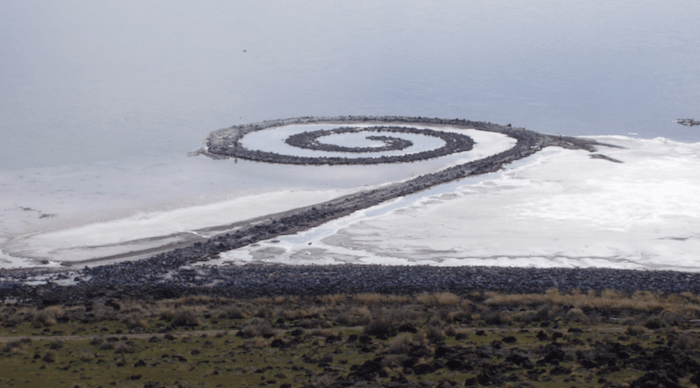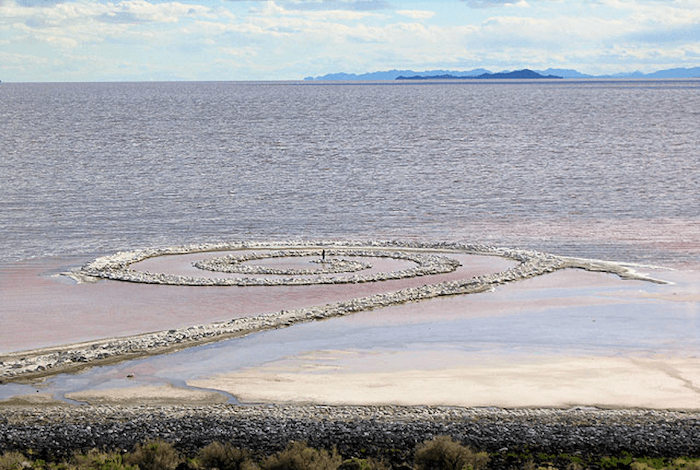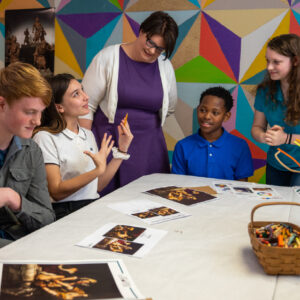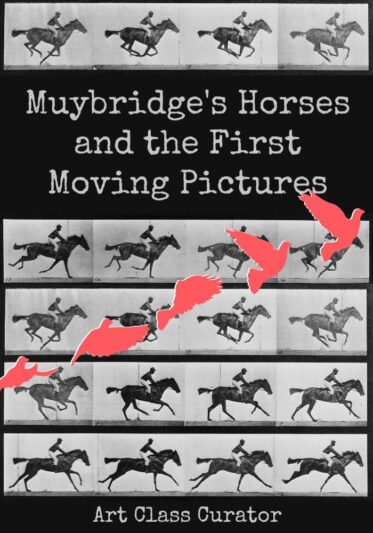Inside: A complete earthworks art lesson about The Spiral Jetty by Robert Smithson, including an earthworks definition and activity ideas.

Earthworks Definition
Earthworks, also known as land art or environmental art, is an art movement that involved artists using natural materials, such as soil or vegetation, to create an artwork in the place where the materials were found. Often, earthworks art was created in difficult to reach areas far from population centers.
What are Earthworks?
Beyond the basic earthworks definition, giving students the context behind the art will help them better understand what are earthworks. There were many societal concerns that gave birth to the earthworks art movement. Earthworks became popular in the 1960s and 1970s, especially in the United States and Great Britain. This time period was marked by a social rejection of urban living and a growing desire to reconnect with the planet and rural life. Advocates of the earthworks movement sought to move beyond the commercialization of art-making. Many of the artists hoped to inspire an ecological movement with their works.

The Spiral Jetty
The Spiral Jetty is perhaps the most well-known earthworks art. Created by pioneer of the earthworks art movement Robert Smithson in 1970, the The Spiral Jetty is located in Great Salt Lake, Utah. To reach the location of the artwork, travelers must traverse treacherous, distant roads. Once there, they’ll find a 15 feet (4.572 m) wide and 1,500 feet (457.2 m) long coil made of black basalt rocks and sediment that weighs over 6,000 tons (more than 5443 metric tons).
The Spiral Jetty spent decades under salty water and reappeared only after the area experienced five years of drought. A crusty layer of salt now gives the black basalt rocks a white appearance.

The strata of the Earth is a jumbled museum, embedded in the sediment is a text that contains limits and boundaries which evade the rational order, and social structures which confine art.
-Robert Smithson

Get the Full Lesson!
This Lesson is in The Curated Connections Library!
Find the full lesson from this post along with hundreds of other art teaching resources and trainings in the Curated Connections Library. Click here for more information about how to join or enter your email below for a free SPARKworks lesson from the membership!
Earthworks Art Lesson
There are several ways to approach an earthworks art lesson about The Spiral Jetty. Students can create their own earthworks art piece, compare and contrast how earthworks art changes over time, compare earthworks art to similar art from other periods, examine the meaning of earthworks art, or all of the above!
Earthworks Art Discussion Questions
Discussing earthworks art with your students is a great way to bring some STEAM into your art classroom. Together, you can explore earth science topics like weathering, erosion, conservation, climate change, geology, and more. Here are some questions to get a discussion about The Spiral Jetty started:
- What is going on here? What do you see that makes you say that?
- Why would the artist create something like this?
- What do you think was the artist’s meaning or message?
- Is this art? Was it still art when it was submerged underwater? Why or why not?
- What do you think it is made out of? How big do you think this is?
- How does this differ from a sculpture made in the same material (basalt)?
- This is a type of artwork called an earthwork. What do you think an earthwork is?
- How do you think the artwork has changed over time? What caused those changes?
- What caused the rocks to change color?
- What do you think the artwork will look like in another 50 years? 100 years? 1,000 years?

Compare/Contrast Earthworks Activity
Ask students to compare the two images of Smithson’s The Spiral Jetty and write their observations on how it changed over time and predict how it might change in the future. The image on the left was taken right after it was created in 1970 and the other 36 years later in 2006.

Comparing Mound Builders Art to Earthworks Art
Over the course of a 5,000 year period in prehistoric times, many groups of Native Americans built mounds of earth along the Mississippi River in eastern North America. We call these groups Mound Builders, and while they each had their own unique traditions and artworks, they all built mounds.
The mounds were often used as burial places for important leaders, and they also contained objects like jewelry, pottery, artworks, food and more. Temples and important buildings were often placed on top of the mounds.
Mound Builders and earthworks artists used many of the same techniques, setting up a perfect opportunity to compare and contrast their work. You can learn more about the Mound Builders in our Mound Builders Lesson Plan.
Earthworks Art Project
Have students design their own earthworks art either inspired by Robert Smithson’s work or based on their own idea. This can be completed as an individual, group, or class project. If possible, have them plan and create an outdoor installation on your campus grounds in an open area. Encourage students to use grasses, leaves, flowers, rocks, and other natural materials from the schoolyard to create contrasting colors and textures. You can also use a wooden sandbox or plastic pool if the landscape can’t be used. If needed, students could also use shoeboxes to create their designs.





Leave a Comment